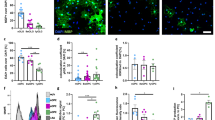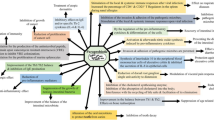Abstract
Environmental enrichment (EE) consists of increased physical, intellectual, and social activity, and has wide-ranging effects, including enhancing cognition, learning and memory, and motor coordination. Animal studies have demonstrated that EE improves outcome of brain trauma and neurodegenerative disorders, including demyelinating diseases like multiple sclerosis, making it a promising therapeutic option. However, the complexity of applying a robust EE paradigm makes clinical use difficult. A better understanding of the signaling involved in EE-based neuroprotection may allow for development of effective mimetics as an alternative. In prior work, we found that exosomes isolated from the serum of rats exposed to EE impact CNS myelination. Exosomes are naturally occurring nanovesicles containing mRNA, miRNA, and protein, which play important roles in cell function, disease, and immunomodulation. When applied to hippocampal slice cultures or nasally administered to naïve rats, EE-serum exosomes significantly increase myelin content, oligodendrocyte precursor (OPC) and neural stem cell levels, and reduce oxidative stress (OS). We found that rat EE exosomes were enriched in miR-219, which is necessary and sufficient for OPC differentiation into myelinating cells. Thus, peripherally produced exosomes may be a useful therapy for remyelination. Here, we aim to better characterize the impact of EE on CNS health and to determine the cellular source of nutritive exosomes found in serum. We found that exosomes isolated from various circulating immune cell types all increased slice culture myelin content, contained miR-219, and reduced OS, suggesting that EE globally alters immune function in a way that supports brain health.







Similar content being viewed by others
References
Allen JA, Barres BA (2009) Glia—more than just brain glue. Nature 457(5):457–677. doi:10.1038/457675a
Arida RM, Scorza FA, Cavalheiro EA (2010) Favorable effects of physical activity for recovery in temporal lobe epilepsy. Epilepsia 51(Suppl 3):76–79. doi:10.1111/j.1528-1167.2010.02615.x
Arranz L, De Castro NM, Baeza I, Maté I, Viveros MP, De la Fuente M (2010) Environmental enrichment improves age-related immune system impairment: long-term exposure since adulthood increases life span in mice. Rejuvenation Res 13(4):415–428. doi:10.1089/rej.2009.0989
Bates DJ, Li N, Liang R, Sarojini H, An J, Masternak MM, Bartke A, Wang E (2010) MicroRNA regulation in Ames dwarf mouse liver may contribute to delayed aging. Aging Cell 9(1):1–18. doi:10.1111/j.1474-9726.2009.00529.x
Beebe LH, Tian L, Morris N, Goodwin A, Allen SS, Kuldau J (2005) Effects of exercise on mental and physical health parameters of persons with schizophrenia. Issues Mental Health Nurs 26(6):661–676. doi:10.1080/01612840590959551
Brahmachari S, Fung YK, Pahan K (2006) Induction of glial fibrillary acidic protein expression in astrocytes by nitric oxide. J Neuroscience 26(18):4930–4939. doi:10.1523/JNEUROSCI.5480-05.2006
Budde H, Schmitt S, Fitzner D, Opitz L, Salinas-Riester G, Simons M (2010) Control of oligodendroglial cell number by the miR-17-92 cluster. Development 137(13):2127–2132. doi:10.1242/dev.050633
Chomiak T, Hu B (2009) What is the optimal value of the g-ratio for myelinated fibers in the rat CNS? A theoretical approach. PloS One 4(11):e7754. doi:10.1371/journal.pone.0007754
Crescentini C, Urgesi C, Fabbro F, Eleopra R (2014) Cognitive and brain reserve for mind-body therapeutic approaches in multiple sclerosis: A review. Restor Neurol Neurosci. doi:10.3233/RNN-130364
Darabaneanu S, Overath CH, Rubin D, Lüthje S, Sye W, Niederberger U, Weisser B (2011) Aerobic exercise as a therapy option for migraine: a pilot study. Int J Sports Med 32(6):455–460. doi:10.1055/s-0030-1269928
De la Fuente M, Gimenez-Llort L (2010) Models of aging of neuroimmunomodulation: strategies for its improvement. Neuroimmunomodulation 17(3):213–216. doi:10.1159/000258727
Dugas JC, Cuellar TL, Scholze A, Ason B, Ibrahim A, Emery B, Barres BA (2010) Dicer1 and miR-219 Are required for normal oligodendrocyte differentiation and myelination. Neuron 65(5):597–611. doi:10.1016/j.neuron.2010.01.027
Fares RP, Belmeguenai A, Sanchez PE, Kouchi HY, Bodennec J, Morales A, Bezi L (2013) Standardized environmental enrichment supports enhanced brain plasticity in healthy rats and prevents cognitive impairment in epileptic rats. Plos One 8(1):e53888. doi:10.1371/journal.pone.0053888
Fields RD (2008) White matter in learning, cognition and psychiatric disorders. Trends Neurosci 31(7):361–370. doi:10.1016/j.tins.2008.04.001
Fratiglioni L, Paillard-Borg S, Winblad B (2004) An active and socially integrated lifestyle in late life might protect against dementia. Lancet Neurol 3(6):343–353. doi:10.1016/S1474-4422(04)00767-7
Grinberg YY, van Drongelen W, Kraig RP (2012) Insulin-like growth factor-1 lowers spreading depression susceptibility and reduces oxidative stress. J Neurochem 122(1):221–229. doi:10.1111/j.1471-4159.2012.07763.x
Grinberg YY, Dibbern ME, Levasseur VA, Kraig RP (2013) Insulin-like growth factor-1 abrogates microglial oxidative stress and TNF-α responses to spreading depression. J Neurochem 126(5):662–672. doi:10.1111/jnc.12267
Guy J, Ellis EA, Hope GM, Emerson S (1991) Maintenance of myelinated fibre g ratio in acute experimental allergic encephalomyelitis. Brain 114(Pt 1):281–294
Hulse RE, Swenson WG, Kunkler PE, White DM, Kraig RP (2008) Monomeric IgG is neuroprotective via enhancing microglial recycling endocytosis and TNF-alpha. J Neurosci 28(47):12199–12211. doi:10.1523/JNEUROSCI.3856-08.2008
Hutchison ER, Kawamoto EM, Taub DD, Lal A, Abdelmohsen K, Zhang Y, Mattson MP (2013) Evidence for miR-181 involvement in neuroinflammatory responses of astrocytes. Glia 61(7):1018–1028. doi:10.1002/glia.22483
Jankowsky JL, Melnikova T, Fadale DJ, Xu GM, Slunt HH, Gonzales V, Savonenko AV (2005) Environmental enrichment mitigates cognitive deficits in a mouse model of Alzheimer’s disease. J Neurosci 25(21):5217–5224. doi:10.1523/JNEUROSCI.5080-04.2005
Kan AA, van Erp S, Derijck AA, de Wit M, Hessel EV, O’Duibhir E, de Jager W, Van Rijen PC, Gosselaar PH, de Graan PN, Pasterkamp RJ (2012) Genome-wide microRNA profiling of human temporal lobe epilepsy identifies modulators of the immune response. Cell Mol Life Sci 69(18):3127–3145. doi:10.1007/s00018-012-0992-7
Kunkler PE, Kraig RP (1997) Reactive astrocytosis from excitotoxic injury in hippocampal organ culture parallels that seen in vivo. J Cereb Blood Flow Metab 17(1):26–43. doi:10.1097/00004647-199701000-00005
Lau P, Verrier JD, Nielsen JA, Johnson KR, Notterpek L, Hudson LD (2008) Identification of dynamically regulated microRNA and mRNA networks in developing oligodendrocytes. J Neurosci 28(45):11720–11730. doi:10.1523/JNEUROSCI.1932-08.2008
Marashi V, Barnekow A, Ossendorf E, Sachser N (2003) Effects of different forms of environmental enrichment on behavioral, endocrinological, and immunological parameters in male mice. Horm Behav 43(2):281–292. doi:10.1016/S0018-506X(03)00002-3
McOmish CE, Hannan AJ (2007) Enviromimetics: exploring gene environment interactions to identify therapeutic targets for brain disorders. Expert Opin Ther Targets 11(7):899–913. doi:10.1517/14728222.11.7.899
Obiang P, Maubert E, Bardo I, Nicole O, Launay S, Bezin L, Agin V (2011) Enriched housing reverses age-associated impairment of cognitive functions and tPA-dependent maturation of BDNF. Neurobiol Learn Mem 96(2):121–129. doi:10.1016/j.nlm.2011.03.004
Passineau MJ, Green EJ, Dietrich WD (2001) Therapeutic effects of environmental enrichment on cognitive function and tissue integrity following severe traumatic brain injury in rats. Exp Neurol 168(2):373–384. doi:10.1006/exnr.2000.7623
Pedersen BK, Hoffman-Goetz L (2000) Exercise and the immune system: regulation, integration, and adaptation. Physiol Rev 80(3):1055–1081
Pfaffl MW (2001) A new mathematical model for relative quantification in real-time RT-PCR. Nucleic Acids Res 29(9):e45. doi:10.1093/nar/2909e45
Ponomarev ED, Veremeyko T, Weiner HL (2013) MicroRNAs are universal regulators of differentiation, activation, and polarization of microglia and macrophages in normal and diseased CNS. Glia 61(1):91–103. doi:10.1002/glia.22363
Pusic AD, Kraig RP (2014) Youth and environmental enrichment generate serum exosomes containing miR-219 that promote CNS myelination. Glia 62(2):284–299. doi:10.1002/glia.22606
Pusic AD, Grinberg YY, Mitchell HM, Kraig RP (2011). Modeling neural immune signaling of episodic and chronic migraine using spreading depression in vitro. J Vis Exp. doi:10.3791/2910
Pusic AD, Pusic KM, Clayton BLL, Kraig RP (2014a) IFNγ-stimulated dendritic cell exosomes as a potential therapeutic for remyelination. J Neuroimmunol 266(1–2):12–23. doi:10.1016/j.jneuroim.2013.10.014
Pusic KM, Pusic AD, Kemme J, Kraig RP (2014b) Spreading depression requires microglia and is decreased by their M2a polarization from environmental enrichment. Glia 62(7):1176–1194. doi:10.1002/glia.22672
Pusic AD, Mitchell HM, Kunkler PE, Kraig RP (2015) Spreading depression transiently disrupts myelin via interferon-gamma signaling. Exp Neurol 264:43–54. doi:10.1016/j.expneurol.2014.12.001
Salminen A, Ojala J, Kaarniranta K, Haapasalo A, Hiltunen M, Soininen H (2011) Astrocytes in the aging brain express characteristics of senescence-associated secretory phenotype. Eur J Neurosci 31(1):3–11. doi:10.1111/j.1460-9568.2011.07738x
Singhal G, Jaehne EJ, Corrigan F, Baune BT (2014) Cellular and molecular mechanisms of immunomodulation in the brain through environmental enrichment. Front Cell Neurosci 8:97. doi:10.3389/fncel.2014.00097
Steele ML, Robinson SR (2012) Reactive astrocytes give neurons less support: implications for Alzheimer’s disease. Neurobiol Aging 423(e1–423):e13. doi:10.1016/j.neurobiolaging.2010.09.018
Stern Y (2012) Cognitive reserve in ageing and Alzheimer’s disease. Lancet Neurol 11(11):1006–1012. doi:10.1016/S1474-4422(12)70191-6
Ströhle A, Stoy M, Graetz B, Scheel M, Wittmann A, Gallinat J, Hellweg R (2010) Acute exercise ameliorates reduced brain-derived neurotrophic factor in patients with panic disorder. Psychoneuroendocrinology 35(3):364–368. doi:10.1016/j.psyneuen.2009.07.013
Van Dellen A, Blakemore C, Deacon R, York D, Hannan AJ (2000) Delaying the onset of Huntington’s in mice. Nature 404(6779):721–722. doi:10.1038/35008142
Varkey E, Cider A, Carlsson J, Linde M (2011) Exercise as migraine prophylaxis: a randomized study using relaxation and topiramate as controls. Cephalalgia 31(14):1428–1438. doi:10.1177/0333102411419681
Yang S, Li C, Qiu X, Zhan L, Lu W, Chen L, Zhao YY, Shi XY, Huang CX, Cheng GH, Tang Y (2013) Effects of an enriched environment on myelin sheaths in the white matter of rats during normal aging: a stereological study. Neuroscience 234:13–21. doi:10.1016/j.neuroscience.2013.01.003
Zhao X, He X, Han X, Yu Y, Ye F, Chen Y, Lu QR (2010) MicroRNA-mediated control of oligodendrocyte differentiation. Neuron 65(5):612–626. doi:10.1016/j.neuron.2010.02.018
Zhao YY, Shi XY, Qi X, Lu W, Yang S, Li C, Tang Y (2012) Enriched environment increases the myelinated nerve fibers of aged rat corpus callosum. Anat Rec 295(6):999–1005. doi:10.1002/ar.22446
Acknowledgments
This work was supported by the National Institutes of Health Common Fund, through the Office of Strategic Coordination/Office of the Director (5UH2 TR000918-02, 4UH3TR000918-03, 3UH2 TR000918-02S1, and 3UH3TR000918-03S1), core facilities funds from the National Center for Advancing Translational Sciences of the National Institutes of Health (UL1 TR000430), the National Institute of Neurological Disorders and Stroke (NS-019108), and the National Institute of Child Health and Human Disorders (5PO1 HD-09402). We thank Dr. Lisa Won and Jason Schumer for reading and commenting on the manuscript. We also thank Dr. Y. Chen for assistance with immunostaining and electron microscopy. Electron microscopy was performed at the University of Chicago Electron Microscopy Facility.
Author information
Authors and Affiliations
Corresponding author
Ethics declarations
Conflict of interest
The authors report a patent pending entitled, “Exosomes-Based Therapeutics Against Neurodegenerative Disorders” that involves exosomes containing microRNA that promote myelination and prevent spreading depression.
Additional information
Kae M. Pusic and Aya D. Pusic contributed equally to this work.
Rights and permissions
About this article
Cite this article
Pusic, K.M., Pusic, A.D. & Kraig, R.P. Environmental Enrichment Stimulates Immune Cell Secretion of Exosomes that Promote CNS Myelination and May Regulate Inflammation. Cell Mol Neurobiol 36, 313–325 (2016). https://doi.org/10.1007/s10571-015-0269-4
Received:
Accepted:
Published:
Issue Date:
DOI: https://doi.org/10.1007/s10571-015-0269-4




